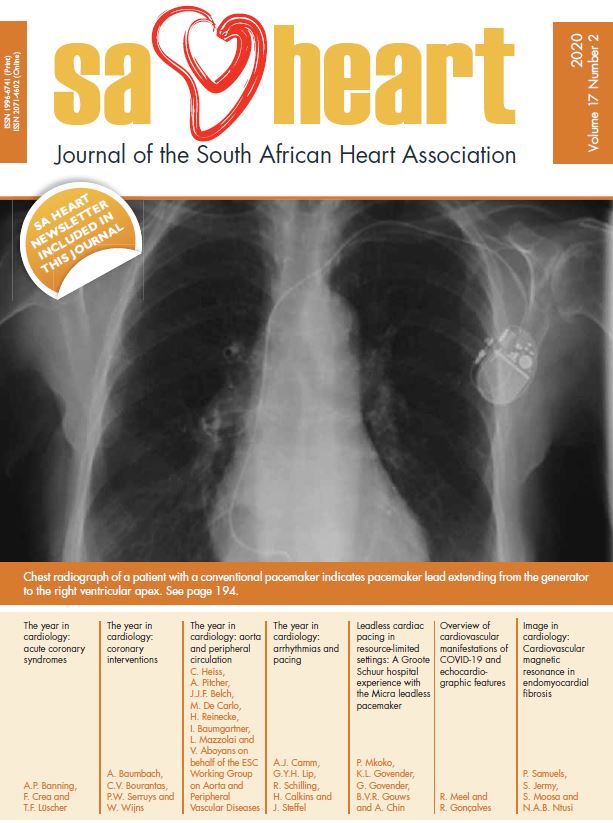Leadless cardiac pacing in resource limited settings: A Groote Schuur hospital experience with the Micra leadless pacemaker
DOI:
https://doi.org/10.24170/17-2-4147Abstract
Background: Cardiac pacemakers improve survival and quality of life in patients with atrioventricular (AV) block. However, conventional pacemakers carry a small risk of both acute and chronic lead and pacemaker generator complications. Leadless pacemakers negate these risks by not having a pacing lead and a subcutaneous generator. We report our Groote Schuur Hospital experience with the Medtronic Micra transcatheter pacing system (TPS).
Methods: We report a consecutive case series of patients that received the Micra leadless pacemaker. The Micra transcatheter pacemaker, a single chamber ventricular pacemaker, is inserted using a TPS via the femoral vein into the right ventricle. Implantation data were obtained, and medical records were reviewed for the 6 weeks and 1-year follow-up visits.
Results: A total of 5 patients were implanted with a Micra leadless pacemaker from 11 March 2015 - 2 November 2016. Four patients were male and 1 female, with an average age of 64 years. Four patients received the pacemaker for a second- or third-degree AV block and 1 patient received the pacemaker for unexplained syncope and right bundle branch block. The Micra leadless pacemaker was successfully implanted in all patients with no acute implantationrelated complications. One-year follow-up was available for 4 patients with good pacing thresholds, sensitivity and impedance. One patient demised after 9 months post Micra implantation due to unrelated causes (acute myeloid leukaemia).
Conclusion: The Micra leadless pacing system is safe and effective and shows good short-term results in a real-world, resource-limited setting. This form of pacing offers a viable option for patients who require pacing for AV block, especially in patients with vascular access problems or who are at high risk of lead or pacemaker generator complications.Downloads
Downloads
Published
How to Cite
Issue
Section
License
This journal is an open access journal, and the authors and journal should be properly acknowledged, when works are cited.
Authors may use the publishers version for teaching purposes, in books, theses, dissertations, conferences and conference papers.
A copy of the authors’ publishers version may also be hosted on the following websites:
- Non-commercial personal homepage or blog.
- Institutional webpage.
- Authors Institutional Repository.
The following notice should accompany such a posting on the website: “This is an electronic version of an article published in SAHJ, Volume XXX, number XXX, pages XXX–XXX”, DOI. Authors should also supply a hyperlink to the original paper or indicate where the original paper (http://www.journals.ac.za/index.php/SAHJ) may be found.
Authors publishers version, affiliated with the Stellenbosch University will be automatically deposited in the University’s’ Institutional Repository SUNScholar.
Articles as a whole, may not be re-published with another journal.
Copyright Holder: SA Heart Journal
The following license applies:
Attribution CC BY-NC-ND 4.0

